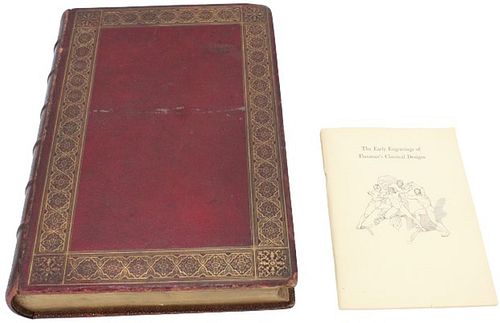Flaxman’s Classical Compositions, Homer, Hesiod, And Aeschylus. This book is actually four works bound in one: the title on the spine reads “Flaxman’s Classical Compositions - Homer, Hesiod, And Aeschylus”, and the four parts inside are titled a) The Iliad Of Homer Engraved From the Compositions Of John Flaxman R. A. Sculptor, London, Printed For Longman, Hurst, Rees & Orme … 1805, b) The Odyssey Of Homer Engraved From the Compositions Of John Flaxman R. A. Sculptor, London, Printed For Longman, Hurst, Rees & Orme … 1805, c) The Theogony Works & Days & The Days Of Hesiod Engraved From the Compositions Of John Flaxman R. A. Sculptor, London, d) Compositions From The Tragedies Of Aeschylus, Designed By John Flaxman, Engraved By Thomas Piroli And Frank Howard, London, 1831, Published By Miss Flaxman & Miss Maria Denman, and e) Compositions From The Tragedies Of Aeschylus Designed By John Flaxman, Engraved By Thomas Piroli, London 1831, Published By Miss Flaxman & Miss Maria Denman. (Miss Flaxman was John Flaxman’s wife.)
(We counted d and e as one work because d only showed the title page and had no engravings in it besides the title page, part a had 39 engraved plates, part b had 34 engraved plates, part c had 37 engraved plates, part d had no engravings except for the title page, and part e had 34 engraved plates, for a total of 144 engravings, and the five title pages for each part made a total of 149 engraved plates in the book).
And it comes with a booklet entitled “The Early Engravings of Flaxman’s Classical Designs”, which contains a bibliographical study by G. E. Bentley from 1964. The booklet is 63 pages long and is a great supplement to the main book, and the Theogony is a poem by Hesiod (8th to 7th century BC) describing the origins and genealogies of the Greek gods, composed around 730 to 700 BC.
The main book has six raised bands, seven compartments with triple gilt-fillet borders, gilt letting and elaborate gilt tooling on the spine, gilt-ruled borders with elaborate gilt-tooling on the front cover, blank endpapers with a penciled note on the front paste-down that mentions “1805
and 1831” (the dates on the chapter titles in the book), the book is bound by J Wright (see the bottom of the front paste down), the engravings are unpaginated, and all the edges are gilt.
John Flaxman (1755-1826) was a British sculptor and draughtsman, a leading figure in British and European Neoclassicism, and one of the greatest sculptors England has ever known. Early in his career, he worked as a modeler for Josiah Wedgwood's pottery, and the main basis for his extraordinary reputation among his contemporaries was the series of engravings made from his outlines for Aeschylus, Dante, Hesiod, the Iliad, and the Odyssey; all but Hesiod were evidently sketched between 1792 and 1793, when he was working in Rome. He was also a prolific maker of funerary monuments, and in 1797 he was made an associate of the Royal Academy.
The book is folio-sized, hefty, and measures 17 x 12 x 2 1/2 in. deep, with a tight binding, light rubbing and scratches on the maroon covers, light wear along the edges of the spine, rubbing at the tips and two tips are turned in, and occasional foxing, and the small booklet is 10 X 7 in. wide and in pretty good condition, with a tight binding, clear text and illustrations, the spine has a three-inch split at the top, light wear and a creased tip on the front cover, one item is circled in pen on page 39, and the back cover has a corner chip at the bottom and a small price tag on it, but just dynamite information about the larger Flaxman book.
Overall an attractive set with great engravings that made the artist.
#5446
Available payment options
We accept all major credit cards, wire transfers, money orders, checks and PayPal. Please give us a call at (941) 359-8700 or email us at SarasotaEstateAuction@gmail.com should you have any questions about payment.






















